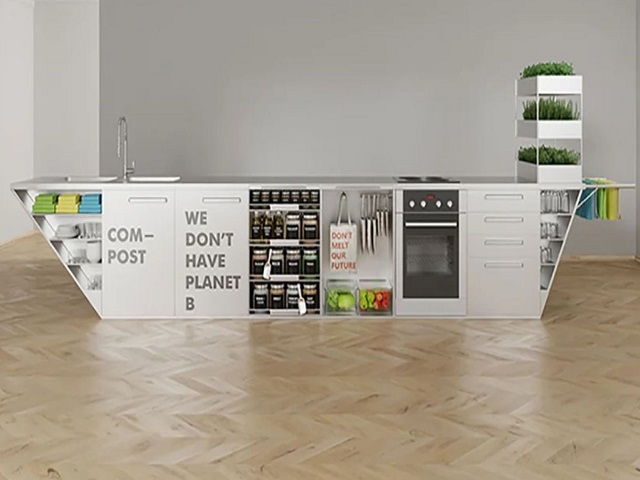Zero-waste’ kitchen inspired by 100-year domestic architecture
Drawing from Margarete Schütte-Lihotzky’s Frankfurt kitchen — a milestone in domestic architecture with a low-cost design that would enable efficient work.
Almost a hundred years later, Ivana Steiner introduces a new ‘zero waste kitchen’ concept that actively contributes to climate protection through a resource-saving lifestyle.

GALLERY
The ‘zero waste kitchen’ has a long shelf life of 150 years; every steel can be recycled several times without the material changing; steel that was once a washing machine, bicycle, or beverage can, is transformed now into something new.
Made with made of recycled stainless steel and recycled glass that works without producing waste – apart from the sustainability, Ivana sought to form a design object that is visually appealing, combined with a political message.
The ‘zero waste kitchen’ functions as a large table around which users can gather to cook or eat together. The structure consists of an elegant form made of stainless steel with areas for glass containers, baskets for regional fruit and vegetables, a worm box, storage space for multi-purpose glasses for dairy products, linen bags and pouches, and a vertical herb garden, where a daylight lamp is needed for the plants if the kitchen is too dark. The humus comes regularly from the worm box and can be used for the herb garden. The only ingredients that cannot be decomposed in the worm box are bones, citrus fruits and garlic.
Furthermore, a tumble dryer is essential for the ‘zero waste kitchen’. This is important because the kitchen uses no rolls and serviettes while working only with textile wipes that can be washed and dried regularly. Meanwhile, the food is not packed but stored in glass containers. The ingredients can be transferred to a glass container with scoops or funnels that one brings with them. The zero waste concept is based on a minimalist lifestyle where users only keep things that they use every day.
The kitchen has two sinks where water can be let in and so the dishes are first washed with water in the dishwashing liquid and then washed in the second sink with pure water. Compared to the dishwasher, the water consumption is lower or similar, but the electricity that is needed to heat the water is saved. There is a water jug that is supposed to collect the rest of the water and so that the herb garden is watered.
Images by Ivana Steiner via Designboom
Hospitality powerhouse Merivale has announced plans to transform a cluster of heritage buildings in the heart of the ...
Situated above the atelier of renowned sculptor Antoine Bourdelle within the Musée Bourdelle, the newly opened café-restaurant, Le ...
The Sunshine Coast’s nightlife hub, Ocean Street in Maroochydore, is set to welcome its first 12-storey mixed-use tower, ...
Japanese studio Keiji Ashizawa Design has unveiled a serene and minimalist showroom and office for jewellery and fashion ...
In 1968, VOLA revolutionised the modern tap, drawing inspiration from the original designs of Arne Jacobsen and Verner ...













